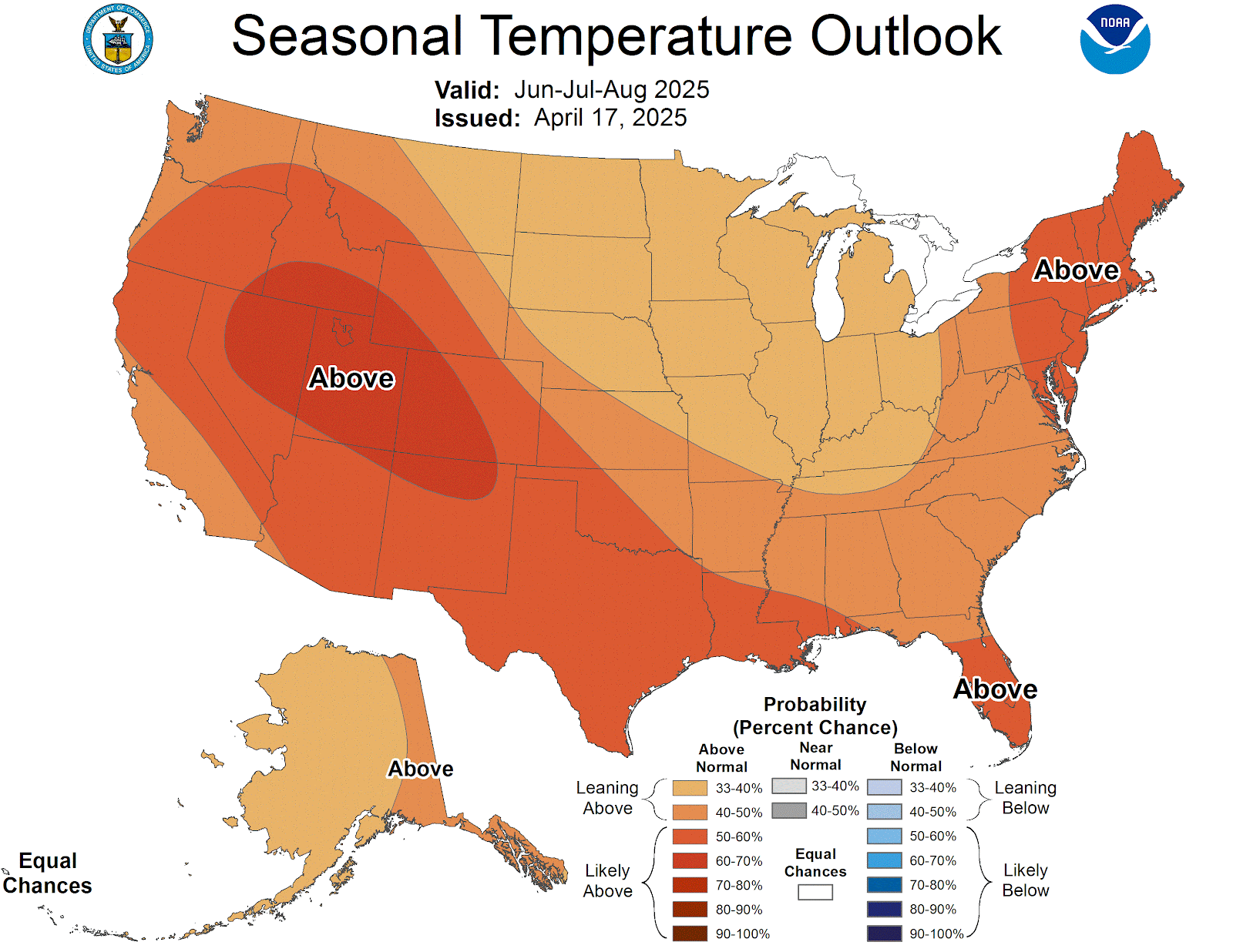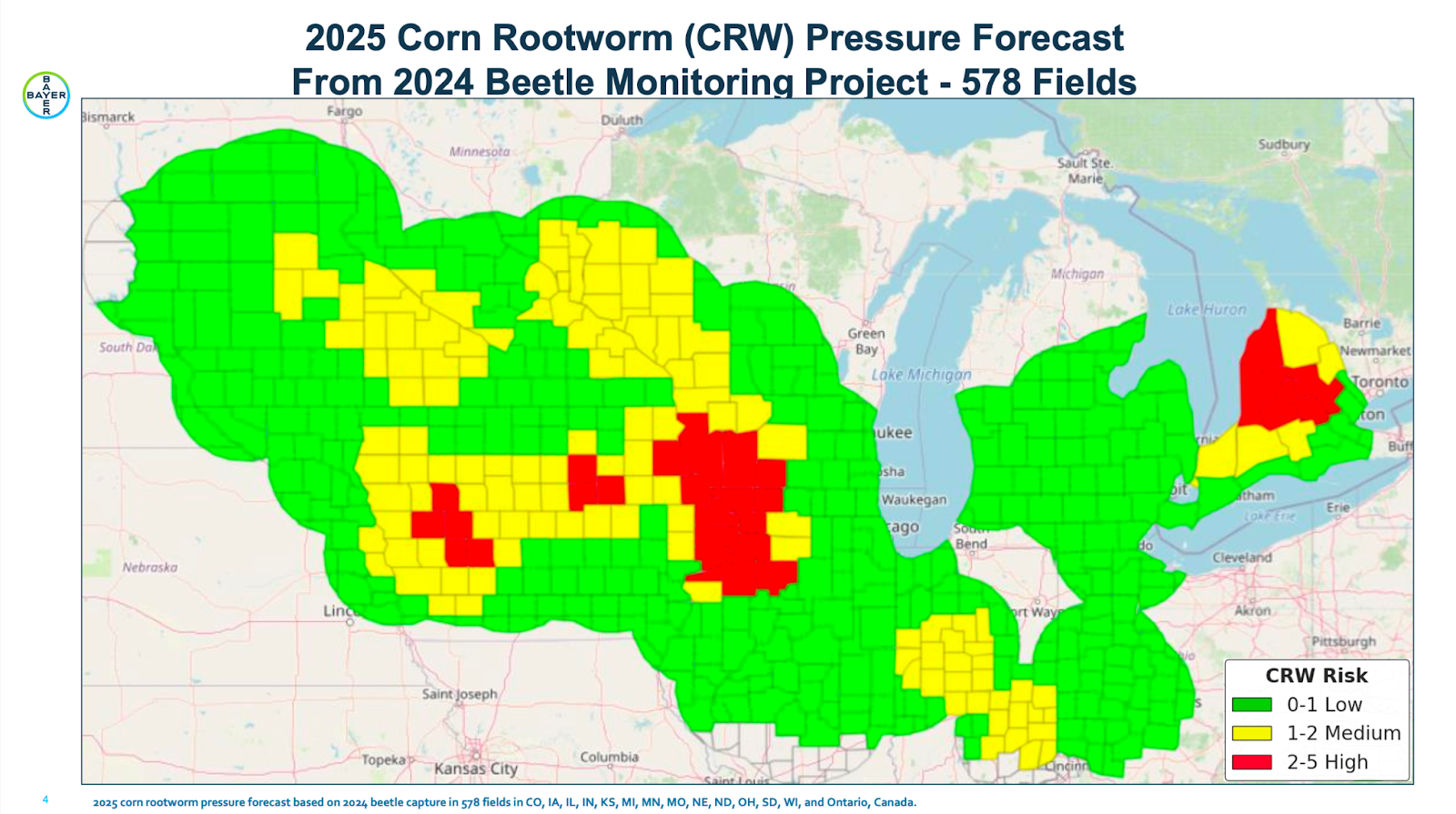AGRONOMICSUPPORT
YOU CAN TAKETO THE FIELD
7 Factors That Will Drive 2025 Yields
As the 2025 growing season approaches, growers across the country are carefully analyzing conditions and making strategic decisions that will impact their success for the entire year. From moisture levels to market dynamics, several key factors will shape growers’ outcomes.
The LG Seeds agronomy team shared seven factors that will define the 2025 growing season — plus how to position your operation to face these challenges.
Key Takeaways:
- Water management remains critical after 2024's moisture extremes, and regional variations will require tailored approaches.
- Selecting the right genetics for specific field challenges is essential to maximize ROI in a tight-margin environment.
- Proactive management strategies for emerging pest and disease threats will help protect yield potential.
1. Water Outlook: Recharging the Water Table
After a challenging 2024 season that saw both excessive early-season moisture and late-season drought in many regions, water management remains a top concern heading into 2025.
Current water table conditions show significant regional variations. Areas across the Midwest that experienced heavy early rains followed by drought in 2024 are still recovering, with soil moisture reserves below optimal levels in many locations. Winter precipitation has helped recharge some of these deficits, but that hasn’t been uniform across growing regions.
- Regional variations will continue to play a major role in 2025:
- Western areas face higher drought risk with below-average soil moisture already evident.
Parts of the eastern Corn Belt are showing elevated chances of a wet spring, according to NOAA predictions.
For fields facing potential drought stress, DroughtGuard® products like LG62C22 have proven their value. It demonstrated outstanding performance across variable farming practices and weather conditions for the second consecutive year. In areas with uncertain moisture outlooks, it’s been a reliable choice.
In areas like Texas, where hurricane-driven rains and subsequent drought created challenging conditions last year, LG65C14 delivered consistent performance across varied rainfall patterns. Its ability to handle excess moisture early and limited moisture late in the season made it a standout performer in these more extreme regions.
2. Heat Forecast and Temperature Trends
Temperature patterns will be another defining factor in 2025. Early projections suggest warmer-than-average nighttime temperatures across many growing regions, which could impact pollination and grain fill periods. Warm nights during key development stages can increase plant respiration. If those temperatures sustain over extended periods, yields can decline.

Sourced from: https://www.cpc.ncep.noaa.gov/products/predictions/long_range/lead02/off02_temp.gif
LG38C48, which made an impressive Big 5 debut last season, demonstrated exceptional plant health and standability even under high heat conditions. "What caught my attention right away was how quickly and uniformly it emerged," says LG Seeds agronomist Tim Beninga. "But what really impressed me was how it maintained outstanding plant health well into the fall. We saw strong stalks and healthy leaves when other hybrids were starting to show wear."
To manage challenging temperatures in 2025:
- Select products with proven heat tolerance and strong plant health.
- Consider staggered planting dates to spread pollination timing.
- Monitor soil moisture closely, as dry conditions can amplify heat stress.
- Be prepared for higher disease pressure if warm, humid conditions persist.
3. Input Cost Analysis and Profitability Outlook
Farm operating margins remain a major concern heading into 2025. Input costs continue to pressure profitability, with operational expenses like fertilizer, fuel and labor still elevated compared to historical averages.
"Farmers are looking at their bottom dollar, and that tends to be their main decision driver," says LG Seeds agronomist Jed Norman. "But financial decisions must be weighed against their agronomic implications."
Norman emphasizes that cost-cutting without considering the agronomic impact can lead to greater expenses down the road. "It can be a snowball effect,” he said. “Making good agronomic decisions today ultimately sets you up long-term. But a short-sighted move to cut costs can cause problems down the road."
To maximize ROI in 2025:
- Focus on efficient nutrient management through soil testing and variable-rate applications.
- Evaluate seed characteristics based on specific field challenges rather than using a one-size-fits-all approach.
- Consider the LG Seeds Seed Comparison Tool to find the best match for your fields' needs and your management style.
4. Market Dynamics: Supply and Demand Factors
The agricultural market landscape continues to evolve, with several factors influencing commodity prices and marketing opportunities for 2025.
Trade uncertainty and potential tariff changes remain a concern, with policy shifts potentially impacting export markets for U.S. crops. Political factors, both domestic and international, add another layer of complexity to market predictions.
Recent changes to agricultural checkoff programs may also influence promotional activities and research funding across commodity groups, potentially affecting long-term market development.
In these uncertain times, staying focused on your operation's fundamentals becomes even more critical. Having a solid agronomic plan can help weather market volatility and position your farm for long-term success. Remember that making sound crop management decisions is something you can control, even when markets are turbulent.
Key advice for navigating market uncertainty:
- Focus on agronomic fundamentals within your control.
- Build flexibility into your marketing plan to adapt to changing conditions.
- Consider diversification strategies to spread risk across your operation.
- Stay informed but avoid making reactive decisions based on short-term market noise.
- Work with your LG Seeds agronomist to develop a tailored plan for your specific operation.
5. Pest Pressure: The Rootworm Challenge
Corn rootworm remains a significant concern heading into 2025, as it continues to expand into many regions. Updated rootworm distribution maps indicate pressure has intensified in traditional hotspots and expanded into areas that previously saw only moderate activity.

Sourced from: https://www.cropscience.bayer.us/articles/channel/corn-product-selection-concerns-with-low-commodity-price
"In corn-on-corn situations, we're seeing more aggressive rootworm populations that are challenging traditional management approaches," Norman noted. "This is where multi-mode-of-action trait packages really prove their value."
For effective rootworm management in 2025:
- Consider SmartStax® PRO technology for fields with high pressure or extended corn rotations.
- To break pest cycles, implement rotation strategies where possible.
- Use sticky traps and root digs to monitor populations throughout the season.
- Develop an integrated pest management (IPM) approach that incorporates traits, rotation and targeted insecticide use.
6. Timing Considerations for the 2025 Season
Historical yield data consistently shows the benefits of early planting when conditions allow. According to field data from the LG Seeds agronomy team, corn planted within the optimal window for each region typically delivers higher yield advantages over late-planted fields.
However, soil conditions should always take precedence over calendar dates. "I like to see the crop sit in the ground for 48 hours before it rains," says LG Seeds agronomist Landon Taylor. "If you know a heavy rain event is coming, you shouldn't be planting all the way until rain clouds cover the sky. Have faith that it's going to dry up, be patient and wait. You've got time."
For 2025 planting decisions:
- Monitor soil temperatures closely and ensure they're at least 50°F before planting.
- Prepare planting equipment early to capitalize on optimal windows.
- Consider a diversified maturity strategy to spread both planting and harvest windows.
7. Disease Outlook and Management
Disease management will be another defining factor in 2025, with tar spot continuing to expand its footprint across the Corn Belt.
After the disease moved into new areas of Minnesota and Wisconsin in 2024, this year shows potential for further expansion. Fields with a history of tar spot should implement proactive management strategies, beginning with product selection.
LG58C73 and LG59C72 have demonstrated strong tar spot tolerance across multiple environments. "The first line of defense for tar spot is a tolerant corn seed like LG58C73 or LG59C72," says LG Seeds agronomist Shane Irlbeck. "We have great tar spot options throughout our lineup."
Southern rust also remains a concern after making significant moves northward in recent seasons. Gray leaf spot continues to be a yield-limiting factor in many environments, particularly in higher-residue systems.
Don't overlook the added protection from quality seed treatments. Many of LG Seeds' corn hybrids are treated with Vayantis® fungicide, providing essential early-season protection against pythium and other yield-robbing diseases. This foundation of protection complements in-season management for comprehensive disease control.
For better disease management in 2025:
- Select products with strong disease packages based on field history.
- In fields with high disease risk, consider split fungicide applications at V5 and tassel.
- Implement a regular scouting program to identify diseases early.
- Work with your agronomist to develop timing strategies for maximum protection.
Setting Your Fields Up for Success in 2025
Looking ahead to the 2025 growing season, these seven factors will significantly influence your operation's success. From water management to disease control, each element requires thoughtful planning and strategic decision-making.
At LG Seeds, we believe every acre counts, and we're committed to helping you achieve dependable performance across your entire farm. Our field-proven products and expert agronomic support can help you navigate these challenges and position your operation for success, regardless of what the season brings.
Partner with your local LG Seeds agronomist to develop a customized plan for your operation. They can help you select the right hybrids, implement effective management strategies and adapt to changing conditions throughout the growing season.






Agronomy Team